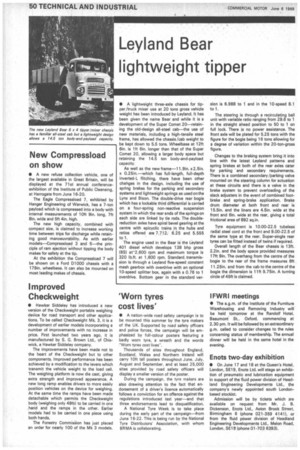Leyland Bear lightweight tipper
Page 52

If you've noticed an error in this article please click here to report it so we can fix it.
• A lightweight three-axle chassis for tipper /truck mixer use at 20 tons gross vehicle weight has been introduced by Leyland. It has been given the name Bear and while it is a development of the Super Comet 20—retaining the old-design all-steel cab—the use of new materials, including a high-tensile steel frame, has allowed the chassis /cab weight to be kept down to 5.5 tons. Wheelbase at 12ft 6in. is 1ft 6in. longer than that of the Super Comet 20, allowing a larger body space but retaining the 14.5 ton body-and-payload capacity.
As well as the new frame-11.9in. x 2.5in. x 0.25in.—which has full-length, full-depth inverted-L flitching, there have been other changes in the design, including the use of spring brakes for the parking and secondary systems and lightweight springs as used onthe Lynx and Bison. The double-drive rear bogie which has a lockable third differential is carried on a four-spring non-reactive suspension system in which the rear ends of the springs on each side are linked by tie rods. The doublereduction axles have spiral bevel gearing at the centre with epicyclic trains in the hubs and ratios offered are 7.712, 6.25 and 5.555 to 1.
The engine used in the Bear is the Leyland 401 diesel which develops 138 bhp gross (BS) at-2,600 rpm and maximum torque is 320 lb.ft. at 1,600 rpm. Standard, transmission is through a Leyland five-speed constant mesh gearbox with overdrive with an optional 10-speed splitter box, again with a 0.76 to 1 overdrive. Bottom gear in the standard ver
sion is 6.988 to 1 and in the 10-speed 8.1 to 1.
The steering is through a recirculating ball unit with variable ratio ranging from 29.6 to 1 in the straight ahead position to 50 to 1 on full lock. There is no power assistance. The front axle will be plated for 5.25 tons with the figure for the bogie being 16 tons allowing for a degree of variation within the 20-ton-gross figure.
Changes to the braking system bring it into line with the latest Leyland patterns and spring brakes at both of the rear axles cater for parking and secondary requirements. There is a combined secondary/parking valve mounted on the steering column for actuation at these circuits and there is a valve in the brake system to prevent overloading of the slack adjusters in the event of combined footbrake and spring-brake application. Brake drum diameter at both front and rear is 15.5in. and the liners are 4.5in. wide at the front and 6in. wide at the rear, giving a total frictional area of 892 sq.in.
Tyre equipment is 10,00-22.5 tubeless radial steel cord at the front and 9.00-22.5 of the same type at the rear. Super-single rear tyres can be fitted instead of twins if required.
Overall length of the Bear chassis is 13ft. 2.2in. and the body space provided measures 17ft 9in. The overhang from the centre of the bogie to the rear of the frame measures 6ft 11.25in. and from the cab to the centre of the bogie the dimension is 11ft 9.75in. A turning circle of 45ft is claimed.


























































































































